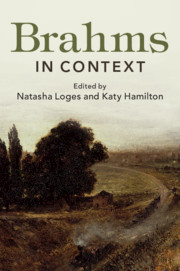Book contents
- Brahms in Context
- Brahms in Context
- Copyright page
- Dedication
- Contents
- Illustrations
- Music Examples
- Notes on Contributors
- Preface
- Abbreviations
- Part I Personality, People and Places
- Part II Identities, Environments and Influences
- Chapter 8 Finances
- Chapter 9 As Pianist
- Chapter 10 As Conductor
- Chapter 11 As Arranger
- Chapter 12 As Editor
- Chapter 13 As Teacher
- Chapter 14 Private Music-Making
- Chapter 15 Concert Life
- Chapter 16 Genre
- Chapter 17 Folk Music
- Chapter 18 Early Music
- Part III Performance and Publishing
- Part IV Society and Culture
- Part V Reception and Legacy
- Further Reading
- Index
- References
Chapter 14 - Private Music-Making
from Part II - Identities, Environments and Influences
Published online by Cambridge University Press: 15 May 2019
- Brahms in Context
- Brahms in Context
- Copyright page
- Dedication
- Contents
- Illustrations
- Music Examples
- Notes on Contributors
- Preface
- Abbreviations
- Part I Personality, People and Places
- Part II Identities, Environments and Influences
- Chapter 8 Finances
- Chapter 9 As Pianist
- Chapter 10 As Conductor
- Chapter 11 As Arranger
- Chapter 12 As Editor
- Chapter 13 As Teacher
- Chapter 14 Private Music-Making
- Chapter 15 Concert Life
- Chapter 16 Genre
- Chapter 17 Folk Music
- Chapter 18 Early Music
- Part III Performance and Publishing
- Part IV Society and Culture
- Part V Reception and Legacy
- Further Reading
- Index
- References
Summary
It is difficult to overestimate the importance of private musical activity as a testing ground, a compositional setting and, indeed, as a pleasurable activity for Brahms. ‘Private music-making’ deserves a word of explanation first, since private spaces were not always in the home, performers were not always amateurs and repertoire was not strictly divided according to public or private consumption. While Brahms was clearly often concerned to write music suitable for amateur performers, such repertoire was not automatically excluded from the concert platform as a result. Indeed, since the public lied recital was an innovation during his lifetime, some of the pieces which had previously found readier advocates in the domestic space were pushed further into the limelight thanks to pioneering programmers such as Gustav Walter and Amalie Joachim [see Ch. 19 ‘Singers’].
- Type
- Chapter
- Information
- Brahms in Context , pp. 130 - 137Publisher: Cambridge University PressPrint publication year: 2019
References
Further Reading
- 1
- Cited by

